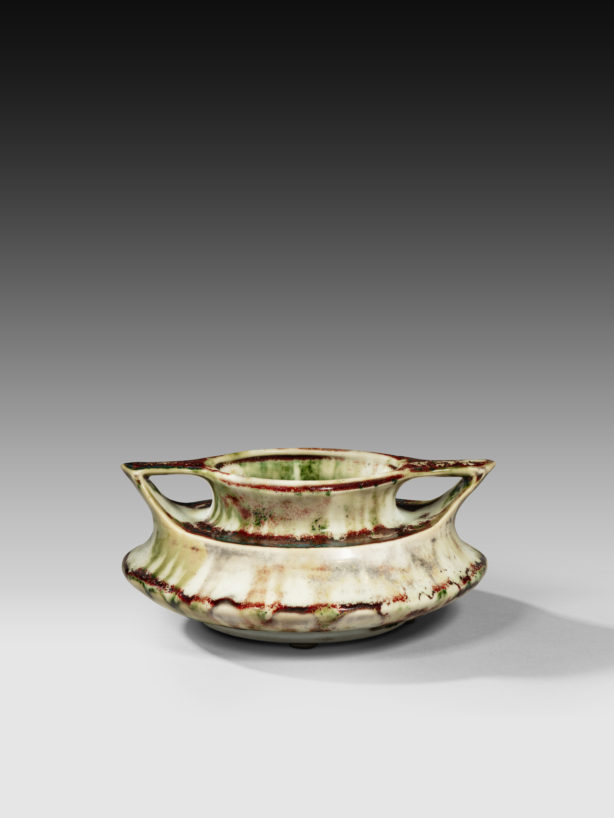Coupe by Dalpayrat (1844-1910)
Oblong in shape, our elegant bowl has two slender handles. The whole piece is decorated with the famous glaze developed by Dalpayrat: oxblood red, green, blue and ochre coulures.
If the first revelation of Japanese art to Parisian artists was the print, ceramics remains without doubt the other most fertile French enthusiasm, particularly for Dalpayrat. The Parisian collections he visited featured not only pots, but also masks, such as the one on display at the Musée de Sèvres as early as 1876. In 1878, once again for the Exposition Universelle, the Japanese craze was revealed, notably for stoneware tea ceremony pieces, which encouraged Pierre-Adrien Dalpayrat to create pieces in plant and animal forms. From the 1890s onwards, ceramists and glassmakers created a new style, breaking with the past. Ceramics adopted organic, asymmetrical lines. Firing accidents, flame effects and glaze drips created abstract decorations that revolutionized the art of fire.
It was also at this time that Dalpayrat abandoned the appellation “painter on porcelain” and began to define himself as a “ceramist” or “artist-ceramist”. He devoted himself mainly to stoneware, a material revered not only for its Japanese associations, but also for its association with traditional French utensils. His sudden interest in this material may well have been inspired by the much-publicized success of Ernest Chaplet and Auguste Delaherche at the 1889 Exposition Universelle de Paris.
With its oblong body and elegant simplicity of form, our vase recalls the traditional shapes of French craftsmanship. But it’s the colorist’s work on the enamel that is particularly noteworthy here. Oxblood red enamel is one of Pierre-Adrien Dalpayrat’s signatures, so much so that it is often referred to as “Dalpayrat red”. The ceramist, whose work on the border between Art Nouveau and Far Eastern ceramics made him famous, could boast of having unraveled the mystery of this fascinating color, mastered for centuries by the Chinese. In fact, he succeeded in obtaining this hue and these flamed effects on a very resistant stoneware, thanks to the oxidation of the copper and perfect control of the atmosphere and firing time. Beyond the red, shades of green, turquoise and golden-brown appear, adding depth to the piece. This invention was acclaimed several times, notably at the Expositions Universelles and at the Salon de la Société nationale des beaux-arts, as well as at the Georges Petit gallery.
The production of critically acclaimed artistic stoneware reached its peak in the late 1890s. Art critic Louis de Fourcaud praised the beauty of the works exhibited at the Salon each year in the Revue des arts décoratifs:
“M. Dalpayrat and Mme Lesbros exhibited together pots, vases, jugs where beautiful blues and purples form, with a red of rare intensity, like the tapers of unequal bangs or like jaspures where the vivid colors have mutually and splendidly splashed!”
Peter Marino’s extensive collection includes two bowls very similar to ours, one with the same model number “229”.




